
views
Standing from a Sitting or Lying Position

Learn about clicker training. Clicker training is an effective training method backed up by animal science. You'll need to use one short, easily distinguishable signal that you, such as a "clicker," a whistle, or a loud finger snap. Make this sound the exact instant the dog performs the behavior you want to reward. Always follow the sound immediately with a reward, ideally praise and a small treat. Only use this sound for training. The dog may be confused and take longer to train if you use it during play or just to fool around.

Wait for the dog to stand up. One easy way to start the training is to watch the dog while she's sitting or lying down. As soon as she starts to stand on his own, click the clicker (or make the noise), praise her, and give her a treat. If the dog doesn't stand enough on his own, the next two steps provide some alternate ideas.

Convince the dog to stand with a treat. If the dog doesn't figure out that you want him to stand, hold the treat a little in front of and above his nose. Gesture with the treat in forward beckoning motion. The moment the dog stands, click the clicker and give him the treat. The hand gesture can reinforce the command once you eventually stop using treats. If the dog sits up but doesn't stand, try keeping the treat lower in front of him. You can also back up so he has to walk forward to get the treat, but this is not ideal as the dog may learn to follow you anytime you move away, or learn to disobey the "stay" command.
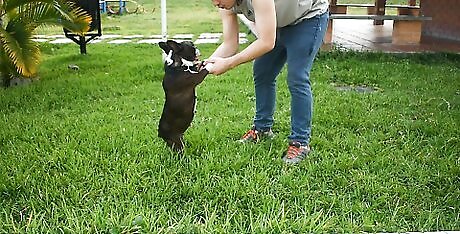
Physically adjust the dog's position. Finally, if the dog does not cooperate with any other method, you can coax the dog upward to a standing position by touching the hind legs, or by gently tugging on the dog's torso. As always, follow this up with the clicker signal and rewards. Dogs tend to take more time to learn what you want when you're physically assisting them, so this is only recommended if the other methods are not working.
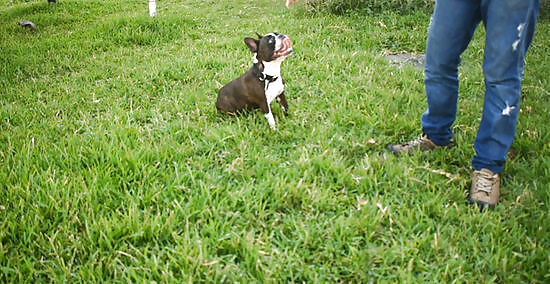
Repeat often. Assuming you have taught your dog to sit or lie down, command him to return to this position. Repeat the clicker and reward as soon as he stands up again. Do this for about two to five minutes, two or three times a day. Always end a training session with the dog in a good mood. If it lasts too long, the dog may get agitated and start resisting the training. Some dogs learn quickly, while others can take weeks. Be patient and never show frustration or aggression, as these set back the training.

Add a verbal command. Once the dog seems to understand the connection between standing and rewards, start associating the verbal command. Say "STAND" each time the dog stands up, in addition to the click and rewards. Eventually, you can skip the treat and just use the verbal command, and perhaps a hand signal. Make sure to praise the dog heavily when he responds.
Standing on Hind Legs
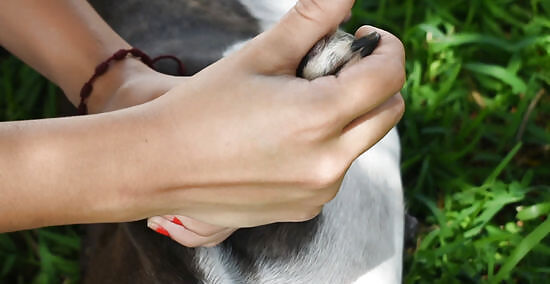
Screen your dog for risk of hip problems. This trick can seriously injure your dog if he has an existing leg condition or weakness caused by genetics or malnutrition. Many breeds are susceptible to hip dysplasia or other leg-related problems, especially (but not only) large breeds such as mastiffs and German shepherds. Before you begin, take your dog to a veterinarian who can examine your dog's hips for possible problems. If you got the dog from a breeder, he may have a third-party certificate confirming that the dog's parents were screened for hip dysplasia. It's even better if the grandparents were tested, since it is possible to pass on the disease through a carrier with no symptoms.
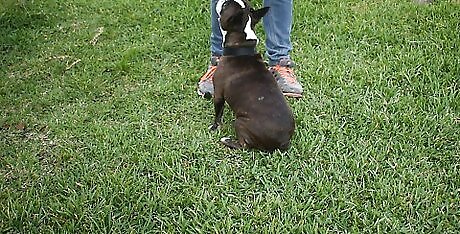
Tell the dog to sit. Assuming your dog is healthy and not at risk for leg issues, get her attention and command her to sit. The better your dog's basic training, the easier this trick will be.
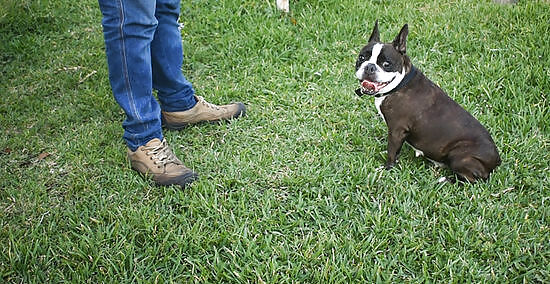
Hold the treat just above the nose. Pick a treat the dog absolutely loves, preferably one with a strong smell. Hold it right above the dog's nose, without letting the dog eat it. If the dog wasn't sitting up already, gesture upward with the treat and encourage him to sit upright.

Raise the treat and command the dog to stand. Lift the treat directly upward. The dog should naturally stand on his hind legs to reach the treat. The instant he does, give the "STAND" command (or a particular hand gesture) and reward him with praise and the treat. If the dog already knows "STAND" as "stand on all fours," use a different command instead, such as "DANCE." Don't expect a great distance on the first try. It's fine to reward the dog for raising him front paws slightly off the ground. Try not to raise it so high that the dog jumps. If the dog does jump, you can reinforce it with the "JUMP" command instead, but teaching two tricks at once isn't ideal.
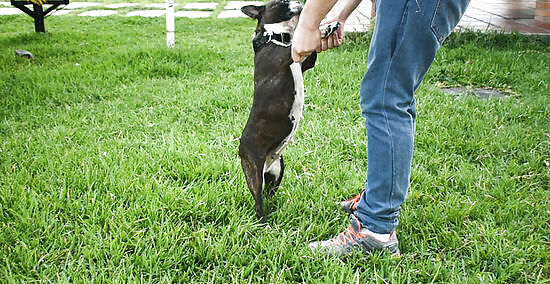
Support your dog's paw (recommended). A dog's leg muscles are not built for a standing position. In the beginning, you may need to to help support the dog by letting him steady his paw against your hand. As he practices this trick, your dog's muscles will develop to support this position, and your dog will learn how to balance.

Repeat in short training sessions. Each session should only be two minutes max. Repeat no more than three times a day. Always end on a positive note, before the dog has tired out. Over time, the dog will learn to respond when you give the "STAND" command.
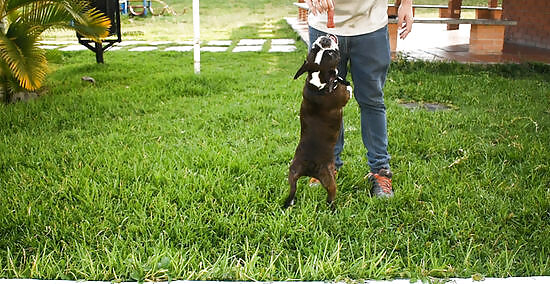
Improve your dog's standing skills. If you like, and if the dog doesn't seem uncomfortable standing, hold the treat higher each time, until the dog can stand fully upright. This will also improve her balance, allowing her to hold the standing position for a little longer. Some dogs can learn to hold this position for a long time and even take a couple steps, but this is generally restricted to smaller, lighter dogs.
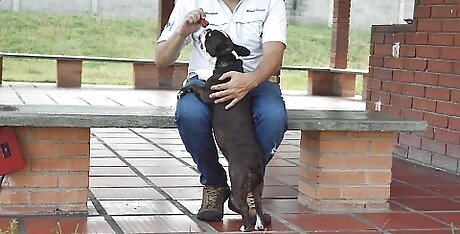
Encourage your dog to stand onto your legs (optional). Most dogs will stand up and place their paws on your legs when they're very excited to see you. If you want your dog to do this more often, encourage this by playing with the dog when it happens, fondling her ears or scratching under the neck. You can also praise them for standing up using a distinct word or sound that you only use for this situation. The dog may associate this sound with standing up, and learn that it's okay to stand on your legs if you say it. If your dog doesn't do this on her own, sit on a chair and call the dog over. Play with the dog and lift the front legs slowly and gently until the front paws are on your knees. Never force the dog to stay in this standing position. It is an unnatural position that causes uncomfortable strain if an unpracticed dog holds it for too long. If you want the dog to sit down again, hold the front paws and help direct them back to the floor, rather than make your dog drop down suddenly.




















Comments
0 comment